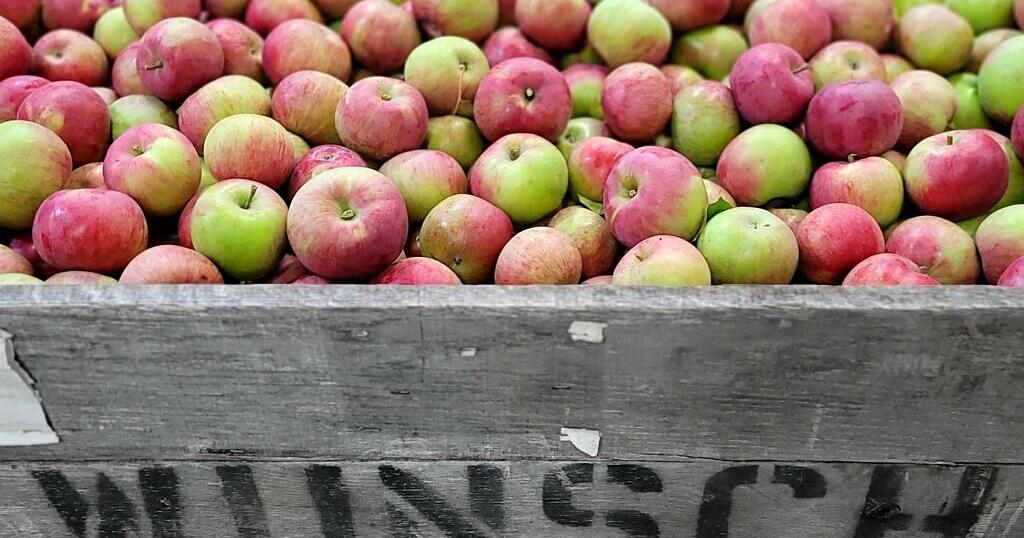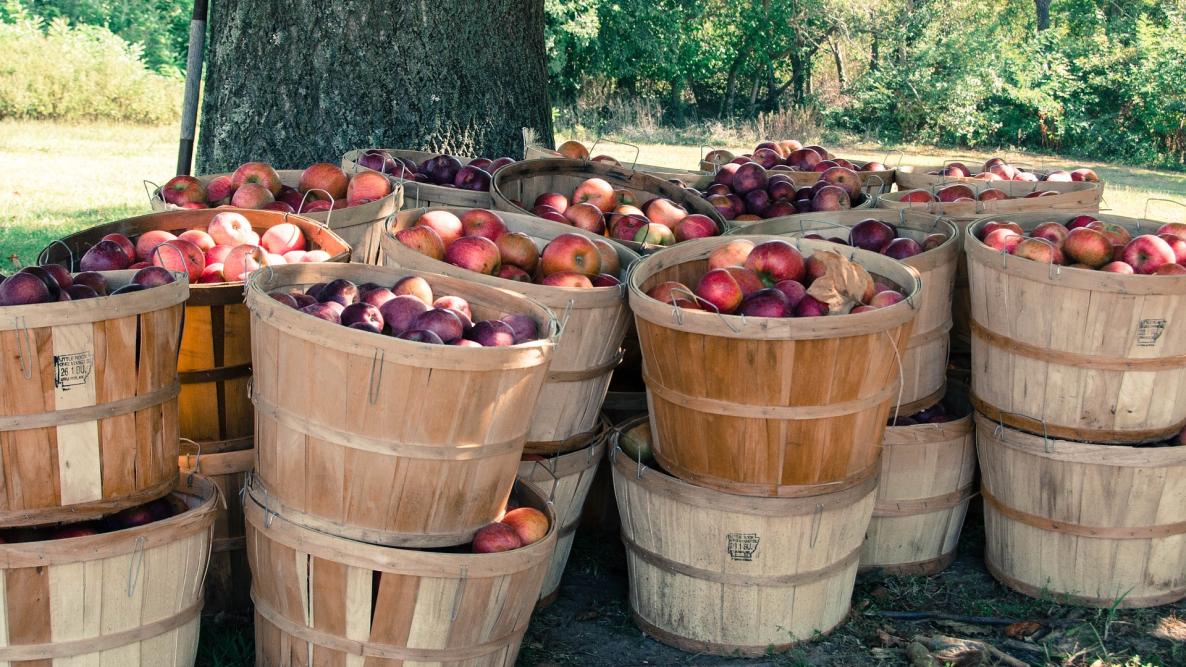Understanding Apple’s measurements is key to efficiency, profitability, and satisfaction within the Apple industry. From knowing what constitutes a bushel of apples to how these measurements impact trade and planning, the importance of standardized measurements cannot be overstated.
In this blog post, we delve into the specifics of “Apples in a Bushel” to unravel the mysteries behind apple measurements and their significance in the industry.
Understanding Apple Bushels: A Guide for Everyone

Apple bushels are a common unit of measure used in the apple industry to determine how many apples you’re getting. It’s like a standard-sized box for apples, but instead of size, it uses volume. One bushel is equal to 8 gallons, which is roughly 35.2 liters.
Why are Apple Bushels Important?
Apple bushels are important for everyone involved with apples, from growers to bakers. Here’s why:
- Standardized Measurement: A bushel is the same size everywhere, so everyone knows exactly how many apples they’re buying or selling. This prevents confusion and ensures fair trade.
- Planning for Recipes: Recipes often call for apples by the bushel. Knowing how many apples are in a bushel helps you figure out how much you need for your apple pie or applesauce.
- Efficiency Throughout the Apple Journey: From farm to table, apple bushels help everyone involved be efficient. Farmers can estimate their harvest, sellers can accurately price apples, and cooks can plan their recipes.
In short, understanding apple bushels helps everyone involved with apples get the most out of them!
How Many Apples in a Bushel?

A bushel is a unit of dry volume commonly used for fruits and vegetables. But how many apples does it actually hold?
On average, a bushel contains around 120 medium-sized apples. However, this number isn’t set in stone.
Why the Variation?
The exact number of apples in a bushel depends on two key factors: size and variety.
- Size: Smaller apple varieties like crabapples or miniatures can pack more apples into a bushel compared to their larger counterparts like Honeycrisp or Fuji.
- Variety: Even within the same variety, the size of individual apples can affect the count. Larger apples naturally take up more space, reducing the total number that can fit in a bushel.
Who Uses Bushel Measurements?
Knowing the average number of apples in a bushel is helpful for several groups:
- Recipe Planning: Home cooks can estimate how many apples they’ll need for a recipe based on the bushel amount.
- Processing and Consumption: Whether you’re making applesauce or just stocking up for the family, knowing the quantity helps with planning.
- Production and Trade: Farmers, suppliers, and consumers can all use this measurement to accurately estimate the volume of apples involved in buying, selling, and harvesting.
By understanding these factors, you can get a better idea of how many apples you’ll get in a bushel, helping you plan your purchases and projects accordingly.
Standard Apple Bushel Size: A Guide for Producers and Consumers

Weight vs. Volume:
The United States Department of Agriculture (USDA) sets the standard size of an apple bushel by weight. A bushel of apples should weigh approximately 48 pounds when filled to capacity. This weight-based standard ensures consistency across different regions and apple varieties.
Benefits of Standardization:
The USDA’s standard bushel size benefits both producers and consumers:
- Fair Trade: It ensures everyone uses the same reference point, preventing confusion and promoting fair trade practices.
- Consistent Quantities: Producers can package apples consistently, and consumers know exactly how much they’re buying.
- Regulation: The standard helps regulate the apple trade, preventing misleading practices.
Standard Dimensions of an Apple Bushel
While the standard is based on weight, there’s also a volume measurement for apple bushels. According to the USDA, a bushel of apples should hold 1.244 cubic feet, which is equivalent to 35.24 liters. This volume measurement provides an additional reference point for producers and consumers.
History and Importance
The standard apple bushel size has a long history dating back to the early 18th century. Originally, apples were sold using heaped measures, which could be inconsistent. The standardized bushel size was established to ensure fairness and accuracy in apple measurement, facilitating trade and commerce within the agricultural industry. By following this standard, both producers and consumers can be confident they’re getting a fair deal.
Apple Bushels Around the World

Regional Variations in Measurement
Did you know that the size of an apple bushel can vary depending on where you are in the world? It’s true! This reflects the unique ways different regions grow and trade apples.
In the United States, for example, a standard apple bushel weighs about 42 pounds (19 kilograms). But in other places, like Europe, the standard bushel might be a different size altogether. These variations highlight the diversity of apple cultivation and trade around the world and how cultural and agricultural traditions influence how we measure apples.
Why the Difference?
These regional differences in apple bushel sizes stem from the diverse agricultural practices and traditions found around the globe. While the US standard bushel weighs 42 pounds, other regions may have their own measurements.
Culture and agriculture play a big role in shaping these bushel sizes. In some areas, people might prefer larger bushels of apples used mainly for cooking or processing. In other regions, apples are eaten fresh or used for cider so that smaller bushels might be more practical. Even the types of apples grown and how they’re harvested can influence bushel sizes.
Understanding these cultural and agricultural influences helps us appreciate the dynamic nature of apple cultivation and its deep connection to local traditions and practices.
Converting Apple Bushels: Pounds, Kilograms, and More

Knowing how to convert apple bushels to other measurements is useful in many situations.
Weight Conversions:
A bushel of apples typically weighs between 42 and 48 pounds. To convert bushels to pounds or kilograms, you can use conversion tables or formulas. For example, 1 bushel is roughly equal to 18.14 kilograms.
Beyond Weight:
Bushels can also be converted to other measurements like cups or quarts, which are handy for recipes and food preservation. Understanding these conversions lets you easily adjust Apple quantities to meet your specific needs.
Pounds and Kilograms:
When converting bushels to pounds or kilograms, you can use conversion tables or formulas. On average, a bushel weighs around 42-48 pounds. Using an average of 45 pounds, we can estimate that 1 bushel is about 20.41 kilograms. This conversion is helpful for figuring out the weight of a large amount of apples or comparing quantities in different units. With this knowledge, you can easily calculate the weight of apples in pounds or kilograms based on the number of bushels.
Practical Uses:
Understanding how to convert apple bushels has many practical applications. Here are a few examples:
- Farmers and orchard owners can determine the weight of apples for packaging and transportation and estimate the number of apples needed for processing or recipes.
- Wholesalers and retailers: They can use these conversions to price and sell apples by weight accurately. It also allows for easy comparison of apple quantities across different units, enabling efficient trade and market analysis.
By converting apple bushels to pounds or kilograms, various sectors of the apple industry gain valuable information.
Apple Bushel Measurements: A Guide for the Apple Industry
Understanding apple bushel measurements is essential for everyone involved in the apple industry, from farmers to consumers. This knowledge ensures accurate communication and informed decision-making throughout the Apple supply chain.
- Estimating Quantities: By knowing the average number of apples in a bushel, how this number varies with apple size and type, and the standard dimensions of a bushel basket, individuals can accurately estimate apple quantities.
- Facilitating Trade: Converting apple bushels to pounds or kilograms is crucial for packaging, transporting, and pricing apples. It also simplifies recipe calculations for large quantities.
In short, familiarity with apple bushel measurements promotes efficiency and informed decision-making within the apple industry.
Benefits of Understanding Apple Bushels
There are numerous benefits to understanding apple bushel measurements for various players in the apple industry:
- Farmers and Orchard Owners: Can accurately estimate and plan harvests, maximizing yield and profitability.
- Wholesalers and Retailers: Can efficiently manage inventory and pricing based on bushel measurements.
- Consumers: Can make informed decisions when purchasing apples in bulk, understanding the exact quantity they are getting.
- Everyone: Bushel measurements allow for easy conversion to other units like pounds or kilograms, simplifying tasks like packaging and transportation.
Overall, knowledge of apple bushels enhances efficiency, profitability, and satisfaction within the apple industry.
References:
FAQ About “Apples In A Bushel: Understanding Apple Measurements”
Q: What is a bushel of apples?
A: A bushel is a unit of volume that typically holds around 42-48 pounds of apples, depending on the apple size.
Q: How many apples are in a bushel?
A: The number of apples in a bushel can vary depending on the size of the apples, but it usually ranges from 100 to 150 apples.
Q: Why are apples sold by the bushel?
A: Apples are often sold by the bushel because it is convenient for both consumers and sellers to measure large quantities of apples.
Q: How many pounds is a peck of apples?
A: A peck is a volume unit that is one-fourth of a bushel and typically holds 10-12 pounds of apples.
Q: Can I buy apples by the bushel at the grocery store?
A: Some grocery stores may sell apples by the bushel, but it is more common to find them sold by the pound or in smaller bags or containers.

Looking for a bar to make your new local hangout? Look no further than Smokin’ Cues, a hidden gem located in the heart of Stockbridge, GA. At our bar & restaurant, we’ve got you covered when it comes to a great time!
Come hear some great live music, catch some sports, have a few drinks, or just sit back and relax! At our pool hall, there’s always something to do.